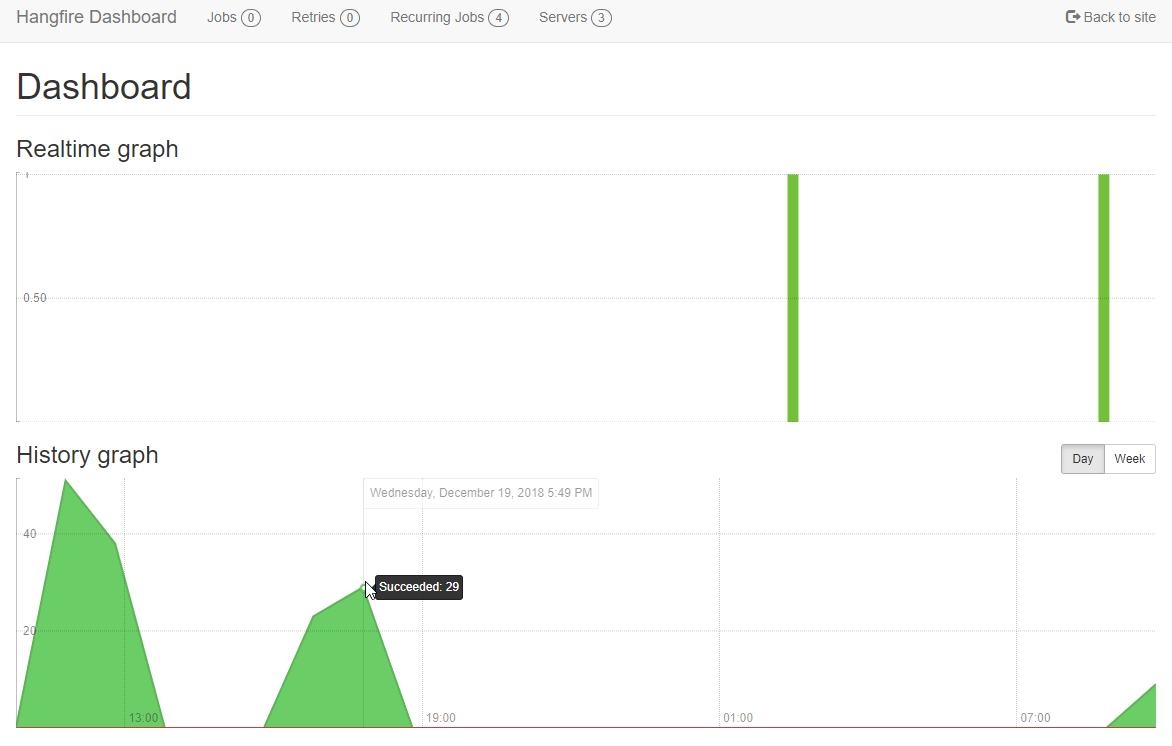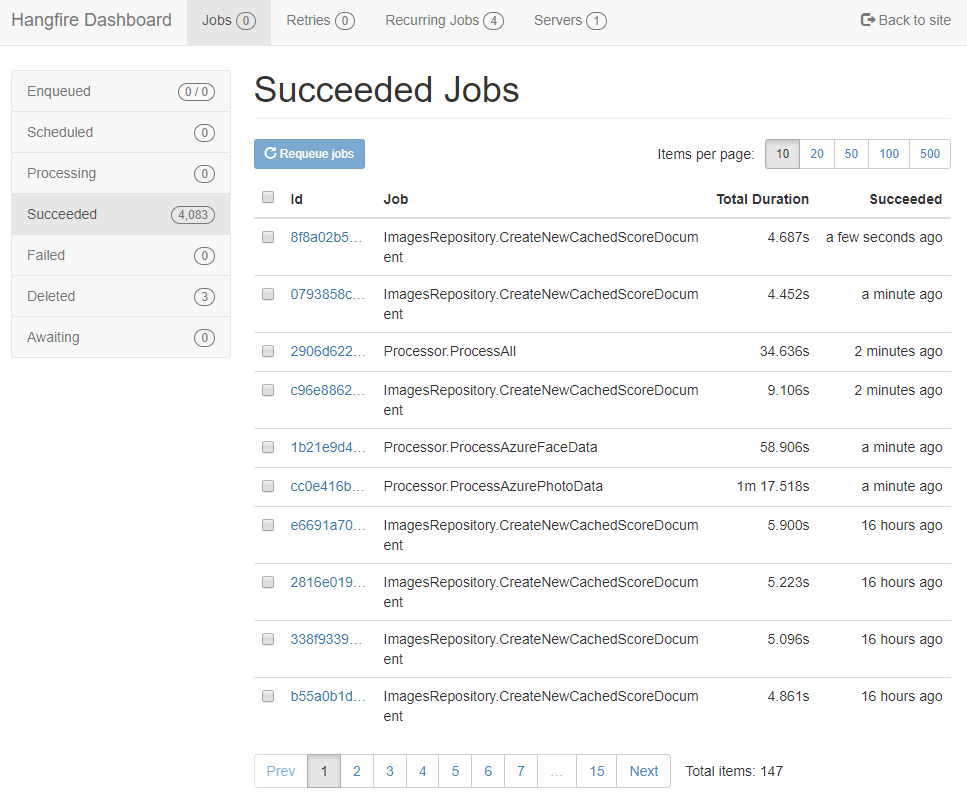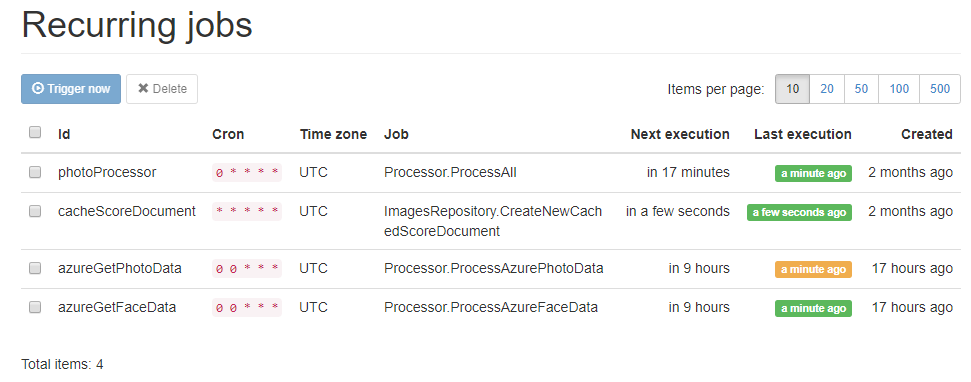services.AddHangfire(x => x.UseCouchbaseStorage(configuration, "familyPhotos_hangfire"));Posts tagged with 'C'
Steve Crow is using Nexmo to communicate. This episode is not sponsored! Want to be a sponsor? You can contact me or check out my sponsorship gig on Fiverr
Show Notes:
-
curl is a command line tool to make HTTP requests
-
OpenAPI initiative
-
A highlight video of Twitch Plays Pokémon (you might want to jump to about 2:30 to get to the good stuff)
-
A video on the Monty Hall Paradox featuring Alan Davies!
Want to be on the next episode? You can! All you need is the willingness to talk about something technical.
Peter Lorimer has built the ASPeKT AOP framework. This episode is sponsored by Uncall.
Show Notes:
-
Other AOP frameworks discussed:
-
We use a bit of AOP terminology. If you need a refresher, check out the terminology posts that cover weaving, cross cutting concern, aspect, advice, pointcut, and join point
-
Book: Adaptive Code via C# by Gary McLean Hall
-
Mono.Cecil is not an AOP framework, but it is a tool to manipulate IL (aka MSIL aka CIL)
-
Unparalleled Adventure blog by Peter Lorimer
Want to be on the next episode? You can! All you need is the willingness to talk about something technical.
Want to be a sponsor? Check out my sponsorship gig on Fiverr
Chris Woodruff is building web APIs with ASP.NET Core. This episode is sponsored by Ivacy.
Show Notes:
-
IIS web server
-
Check out episode 94 with Jeremy Miller on Lamar for more discussion about dependency injection
-
Check out episode 22 with J. Tower on .NET Core for more about .NET Standard.
-
Chris’s baseball API
-
InfoQ stuff:
-
Project Rider from JetBrains
Want to be on the next episode? You can! All you need is the willingness to talk about something technical.
Want to be a sponsor? Check out my sponsorship gig on Fiverr
Merry Christmas! This is the last day of the C# Advent. Make sure to check out all of the other great posts from 2017 and 2018. If you want to be involved next year, look for C# Advent 2019 author sign ups at the end of October 2019, and look for blog posts to start showing up on December 1st, 2019.
What is a background job?
A background job is some code that runs apart from the normal flow of your program. It could be run asynchronously and/or on another thread. As an ASP.NET MVC developer, I tend to think of it as any task that runs outside of an MVC action being invoked.
There’s two kinds of background jobs that I’m aware of:
-
Scheduled - a task that runs every N minutes, or every Y hours, etc. This is what I’m going to show in this post today. It’s great for making periodic checks, ingesting data from some other source, etc.
-
Fire and forget - Some other piece of code kicks off a process to run in the background. It doesn’t block the code (fire), and the code doesn’t wait for a response (forget). This is great for potentially time consuming operations like checking inventory, sending emails, etc, that you don’t need a user to wait for.
What you usually need to do to create background jobs
In my experience, I’ve seen background jobs take a few different forms.
-
Separate Windows service (or Linux daemon, whatever). A console/service program that’s running in addition to your ASP.NET program. This works fine for scheduled jobs.
-
Queueing mechanisms like Kafka or Rabbit. The ASP.NET program will put messages into these queues, which will then be processed by some other program. This is fine for fire-and-forget.
-
Background jobs running within the ASP.NET process itself. In my experience, I’ve used Quartz.NET, which can run within the ASP.NET process. There’s also FluentScheduler (which I’ve not used, and doesn’t seem to come with database integration out of the box?)
With all these options in the past, I’ve experienced deployment difficulties. The wrong version of the service gets deployed, or isn’t running, or fails silently, or needs to be deployed on multiple servers in order to provide scalability/availability etc. It’s totally possible to overcome these challenges, of course. (I should also note that in my experience with Quartz.NET, I never used it in embedded form, and the last time I used it was probably 6+ years ago).
But if I just need a handful of background jobs, I’d much rather just make them part of the ASP.NET system. Yes, maybe this goes against the whole 'microservice' idea, but I don’t think it would be too hard to refactor if you decided you need to go that route. I solve my deployment problems, and as you’ll see with Hangfire (with Couchbase), it’s very easy to scale.
How hangfire works
You can find more details and documentation about Hangfire at Hangfire.io. Really, there are only three steps to setting up Hangfire with ASP.NET Core:
-
Tell ASP.NET Core about Hangfire
-
Tell Hangfire which database to use
-
Start firing off background jobs
In Startup.cs, in the ConfigureServices method:
Then, in Startup.cs, in the Configure method:
app.UseHangfireServer();I’m using Couchbase in this example, but there are options for SQL Server and other databases too. I happen to think Couchbase is a great fit, because it can easily horizontally scale to grow with your ASP.NET Core deployments. It also has a memory-first architecture for low latency storage/retrieval of job data. Generally speaking, even if you use SQL Server as your "main" database, Couchbase makes a great companion to ASP.NET or ASP.NET Core as a cache, session store, or, in this case, backing for Hangfire.
The configuration variable is to tell Hangfire where to find Couchbase:
var configuration = new ClientConfiguration
{
Servers = new List<Uri> { new Uri("http://localhost:8091") }
};
configuration.SetAuthenticator(new PasswordAuthenticator("hangfire", "password"));(In my case, it’s just running locally).
Steps 1 and 2 are down. Next, step 3 is to create some background jobs for Hangfire to process. I’ve created an ASP.NET Core app to assist me in the cataloging of all my family photographs. I want my application to scan for new files every hour or so. Here’s how I create that job in Hangfire:
RecurringJob.AddOrUpdate("photoProcessor", () => processor.ProcessAll(), Cron.Hourly);Note that I didn’t have to implement an IJob interface or anything like that. Hangfire will take any expression that you give it (at least, every expression that I’ve thrown at it so far).
Step 3 done.
Hangfire is just a NuGet package and not a separate process. So no additional deployment is needed.
How do I know it’s working?
Another great thing about Hangfire is that is comes with a built-in dashboard for the web. Back in Startup.cs, in Configure, add this code:
app.UseHangfireDashboard("/hangfire", new DashboardOptions
{
Authorization = new[] {new HangfireAuthorization()}
});I’m using my own HangfireAuthorization implementation because Hangfire only gives permission to local users by default.
Then, you get a nice dashboard right out of the box, showing you a realtime and history graph.

From this dashboard, you can also look at a more detailed history of what’s run and what’s failed.

You can even kick off recurring jobs manually.

This is only the start
If you’re thinking about adding background jobs to your ASP.NET Core solution, why not give Hangfire a try?
Some more things for you to explore:
-
Scaling: every ASP.NET Core site that gets deployed with Hangfire that points to the same database will be able to process jobs too. As your ASP.NET Core site scales out, hangfire scales out with it. This is another reason that Couchbase is a good fit, because it’s also easy to scale out as your site grows.
-
Cloud: If you are deploying your site as an app service, note that Azure will shut down ASP.NET processes if they haven’t been used in a while. This means Hangfire will shut down with them. There are a couple of ways to deal with this. Check out the Hangfire documentation.
-
Retries: Hangfire will retry failed jobs. Design your background job code to expect this.
-
Hangfire Pro: The commercial version of Hangfire is called Hangfire.Pro, and it comes with some interesting looking batch capabilities. I’ve not needed any of this functionality yet, but for more advanced cases you might need this.
-
Couchbase: a NoSQL data platform that has a built-in memory-first cache layer, SQL support, text search, analytics, and more. There are lots of options for working with Couchbase in .NET. For this post, I used the Hangfire.Couchbase library (available on NuGet).
Thank you for being a loyal listener of Cross Cutting Concerns. This is a very short episode, but stay tuned until the end of the episode for a little sneak peak at what's coming next year.
I've really enjoy making these shows, and I hope you find them useful!
I'll be back with new episodes in 2019.
In the meantime, there are a few things you can do to help support the show.
First, if you are using any podcast platform that allows reviews, especially iTunes, leaving a review is very helpful, and helps people find the show.
Second, I've started a new "feedback" page. You can submit ideas and vote on other's ideas. Go to crosscuttingconcerns.com/podcast and click on the LEAVE FEEDBACK button.
I'm especially interested in suggestions for future guests, your thoughts on the JavaScript game this year, and what topics you'd like to hear covered. More COBOL? Less JavaScript? More Nintendo emulation? Less ColdFusion? I want to know. This year was the best year yet, but I think next year will be ever greater with your help.
Third, please tell people about the show! Tweet, facebook, tell your coworkers.
Finally, I'm thankful for my sponsor this year, Smartsheet. Check them out at smartsheet.com/crosscuttingconcerns. I'm also thankful to all the great guests, I can't list them all, but I'm so grateful that I got to meet and hang out with all of you. I want to give special thanks to David Giard for being so supportive and inspirational. Be sure to check out his show Technology and Friends. I also want to give special thanks to Joe Ferg for creating some amazing music, make sure to check out all the excellent stuff he is creating at JoeFerg.com.
I'm thankful for each one of my listeners, and I hope you'll stay with me next year.




